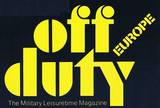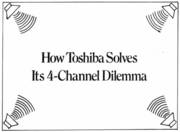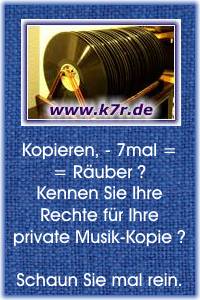"off duty" 1970 - 1997 - eine Freizeit-Zeitung für's US-Militär
Die in diesem amerikanischen (Freizeit-) Shopping-Magazin angepriesenen Hifi- und Video-Produkte waren auschließlich amerikanischen und kanadischen Militärangehörigen zugänglich - also zu kaufen - und vor allem zu ganz ungewöhnlich (verblüffend) niedrigen US $ Military-Preisen. Zu der einführenden "off duty" Seite geht es hier lang. - Um 1970 begann der weltweite Hifi-Boom bis zum 1. Crash 1978 und dann wieder zum 2.Crash um 1990. Über die 20 Jahre nach 2001 lesen Sie mehr in den Kolumnen auf diesen japanischen Seiten.
.
off-duty / Europe / May 1972
How Toshiba Solves Its 4-Channel Dilemma
vom Herausgeber - By WALTER B. RIOS - im Mai 1972
IF THE FOUR-CHANNEL DECISION ......
..... is a tough one for you, the consumer, think what a big risk it is for a manufacturer to guess, months in advance, which way the market is going and design his products accordingly. Should he stick to popular-priced conventional stereo components or plunge ahead with a line of costlier 4-channel equipment? And which of the matrix systems should he employ ?
Looking over a new line-up of components introduced by Toshiba at a recent press conference, I realized that today the manufacturer and customer are in the same boat. And, to keep from falling in the drink, they have to make a few compromises. There's some good thinking going on at Toshiba, a giant company in the radio-TV field but relatively new on the high fidelity components scene.
If you're ready to buy a components rig before shipping home to the States, but wondering which way to go, some of Toshiba's solutions to the 4-channel dilemma may help to guide you.
The matrix is the area of greatest confusion
First, the matrix, since it's the area of greatest confusion and uncertainty. Toshiba has its own system, called QM (for "quadra-matrix"), which is entirely compatible with the fairly standardized matrix systems espoused by Pioneer, Fisher, Kenwood and others.
All are in step with the EV/Scheiber method of encoding four discrete signals into a compatible 2-channel (conventional stereo) signal that can be broadcast or recorded on tape or disc in the normal way.
Sansui's QS matrix, while employing more sophisticated phase-shifting circuitry, is basically similar. This entire group differs, however, from the new CBS/Sony matrix known as SQ.
Despite its relative incompatibility, SQ is acknowledged to be a strong entry in the 4-channel sweepstakes because the weight of Columbia Records will soon be behind it with ample "software."
Toshiba's solution to this matrix dilemma is to build both systems into its new series of 4-channel components, with the circuit change for decoding either QM or SQ accomplished at the flick of a switch.
Toshiba's new 4-channel receivers
There are two receivers in Toshiba's new 4-channel series. Model SA-504 offers 30 watts per channel (at 8 ohms, rated at 0.4 per cent distortion), 53 watts per channel in stereo.
- Anmerkung : Walter Rios wirkte von Beginn an hin auf eine ehrliche Angabe der Verstärkerleistung und lobte dann auch die Firmen, die saubere RMS Spezifikationen angaben.
A lower-priced version with similar styling, model SA-304, has an output of 10 watts per channel in 4-channel operation, 20 watts per channel in stereo.
Distinguishing the front panel of these two units is a large master volume control, surrounded by four smaller knobs permitting the relative level of each channel to be set individually.
Toshiba also offers an integrated 4-channel amplifier, model SB-404, with 17 watts per channel, or 30 watts per channel when switched into BTL for stereo operation. Note, incidentally, that all Toshiba's ratings are in continuous power (RMS), indicative of the trend away from inflated "music power" ratings.
For the customer still diffident about 4-channel, Toshiba has two conventional stereo receivers, Models SA-400 (OFF DUTY, Oct. '71) and SA-500.
Ein Zusatzgerät - der SC-410 decoder/amplifier
They can be converted to 4-channel by means of an accessory, the SC-410 decoder/amplifier. This provides the needed matrix, plus an IC power amplifier (15 watts per channel) to drive the rear speakers. It connects to any receiver or amplifier with separate terminals for preamp and power amp (usually bridged with jumper cables on the rear panel).
Und die Toshiba Ingenieure entwickelten kontinuerlich weiter
While Toshiba kept a low profile on audio components until fairly recently, its mammoth research lab plunged ahead with innovations, particularly in the area of phonograph pickups.
The firm's photo electronic cartridge, C-100 P, introduced several years ago, proved to be a fine performer but too costly to achieve wide-scale commercial success.
Now Toshiba has another unusual design, an electret condensor cartridge with no moving parts except for the stylus cantilever.
Der Toshiba Electret Abtaster
Instead of moving magnets or moving coils, as in conventional cartridges, Toshiba employs a pair of electrets (energized by a small battery pack) to read the change in electric potential as the cantilever moves between them.
The system requires an equalizer quite different from the RIAA equalization built into conventional preamplifiers, so Toshiba offers it as an accessory. This equalizer/preamplifier is also built into Toshiba's SA-504 and SA-500 receivers and SB-404 amplifier.
Und sie entwickelten ein 4-Kanal open reel Bandgerät
Toshiba's open-reel tape decks, PT-862 (stereo) and PT-866 (discrete 4-channel) are moderate- priced 3-head, single-motor designs with relatively standard features, but under the removable headover there's a circuitry innovation, a recording bias control, that's particularly welcome.
Using a screwdriver and the deck's built-in VU meters you can set bias for the particular characteristics of the tape, prior to recording.
Toshiba's loudspeakers, styled along conventional lines, also have something unusual inside, a woofer with concave (instead of convex) cap in the center. Toshiba claims this new-type cone diaphragm reduces distortion at the critical crossover frequencies.
On the cassette front, Toshiba has boarded the Dolby bandwagon, with two decks featuring this type of noise-reduction circuitry. Both have a dual-capstan drive mechanism with hysteresis synchronous motor, and the top-of-the-line PT-490 offers the convenience of automatic reverse.
My Old Records - THE INEVITABLE QUESTION
..... when discussing 4-channel developments, is "Where is the software?"
It came up again during the question-and-answer portion of Toshiba's press conference. And suddenly the real answer struck home.
We've had enough software all along, and there's no need to wait for hundreds of quadraphonic records to be released to enjoy the "new sound."
Certainly it's interesting to audition new records specifically designed to give you surround sound. Predictably, such recordings are coming on strong - Ovation Records, a new label, offers 4-channel exclusively - and also improving in quality as multi-channel recording techniques are refined.
Es werden noch Jahre vergehen
But years will pass before ordinary stereo is entirely supplanted by quadraphony on the new-release scene, and the fine-sounding stereo LPs already in home libraries are hardly ready for the scrap heap.
Having lived a few months with 4-channel sound - a Sansui QS-1 and an extra amplifier added to my years-old stereo components system - I'm ready to report that the novelty wears off after a while (die Neuerungen verschleißen nach eine Weile).
Ping-pong effects are fine for demonstration but if that's all there was to the "New Sound" I could easily do without same. So I look on each new quad release with increasingly jaundiced eyes. Is it going to bore me with "effects" and waste precious time, or will it prove to be good listening ?
Hifi hören zuhause ist sehr individuell
At-home listening is a personal thing. Those who hanker for unusual sonics may prefer playing new quad goodies to the virtual exclusion of conventional stereo, since the latest recordings, granted a few exceptions, often put those of just a few years ago in the shade - for pure sonics, that is.
But as musical perspective grows, the more likely one will return often to earlier, albeit sonically dated, performances by favored artists or composers who've passed from the scene.
Thus I must admit that most of the music I play on my new-fangled quadraphonic system isn't 4-channel at all. Maybe even mono, yet.
Stereo-Platten mit der Quadroanlage klingen besser
But I'll go on record that everything I play - even including not-so-hot TV sound piped through our components system - sounds better with four amplifiers and four speakers than it does with two each.
I've experimented by occasionally shutting off the rear speakers and, sure enough, there's an enormous difference, the front speakers appearing to move away, the music losing fullness and sounding more distant, demanding to be played a lot lounder when not juiced up with a little rear-channel ambience.
So my standard procedure, when playing conventional stereo, is to raise the rear-channel level only to the point where I can hear the rear speakers with my ear a few inches away. Then I move away and forget they' re there.
While I still look forward to new quad releases, I find there's no shortage of software - my old records, and the stereo broadcasts on FM, sound better than ever. ?
vom Herausgeber - By WALTER B. RIOS - im Mai 1972
.






